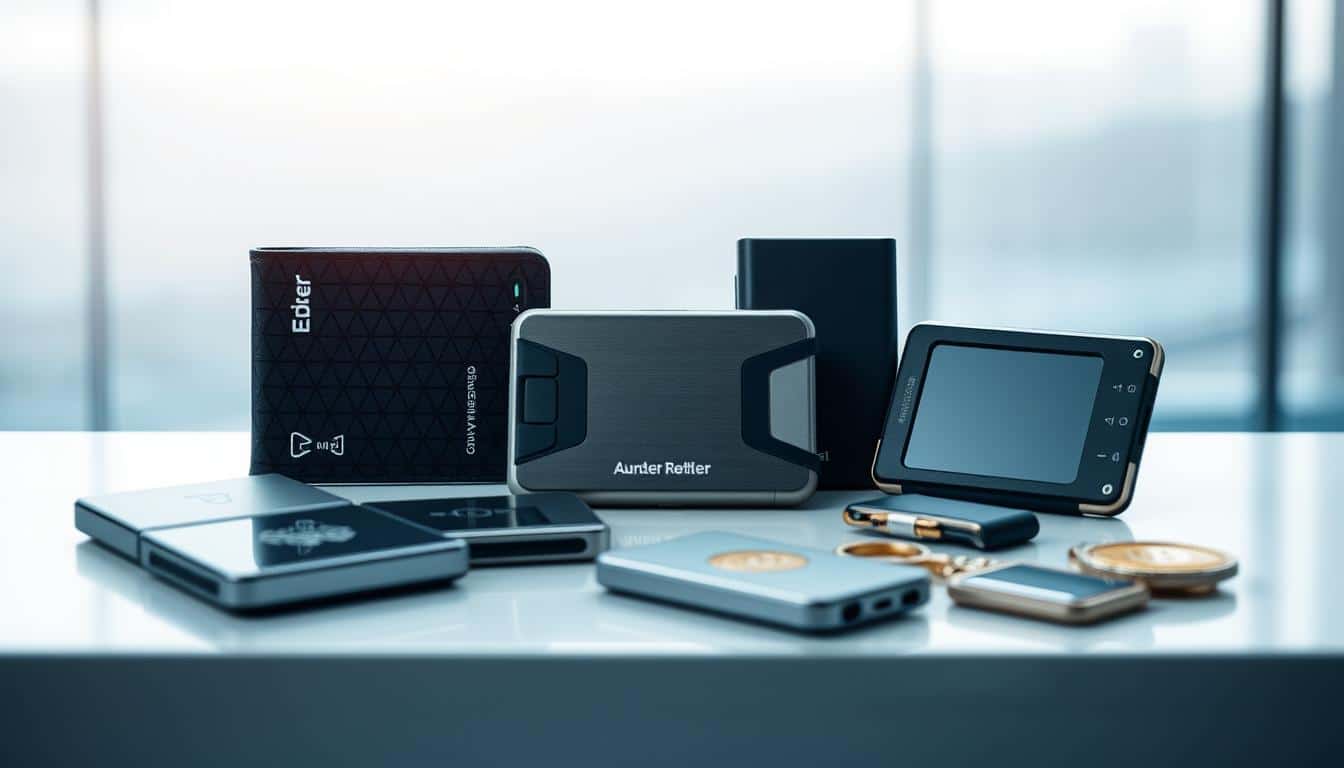Nearly 70% of long-term crypto losses come from bad key management. This fact highlights the vital need for cold storage.
I have hands-on experience with Ledger, Trezor, and SafePal. Through testing, I’ve seen small errors lead to big, unfixable problems. In this article, I’ll compare the safest hardware wallets for storing crypto. I’ll explain why everyone with long-term assets must use secure storage.
I combine lab tests with real-world use to evaluate these wallets. I check their secure chips, backup processes, and everyday interfaces. I also consider how much trust big institutions put in these solutions. For example, custody services from the Bank of New York Mellon and oversight by the New York Department of Financial Services set a high standard. This shows which solutions are crucial for those planning to hold their assets for a long time and for big investors.
Expect a detailed guide with the pros and cons, security considerations, practical usage tips, and the best crypto wallet options across different price points. I’ll discuss secure chip technology, how to recover your assets if something goes wrong, design features, data on security breaches, DeFi signals like Total Value Locked (TVL), and tools to manage your assets. This guide will help you choose a wallet that matches your safety needs.
Key Takeaways
- Cold storage through hardware wallets is the most surefire way to protect crypto for the long run.
- Ledger, Trezor, and SafePal offer different balances between security, ease of use, and cost.
- While trust in institutions and regulations can boost confidence, they can’t replace good personal key management.
- When picking the best crypto wallet for safety, look for secure chips, straightforward backup and recovery processes, and ease of use.
- I’ll share comparison charts, data on breaches, and a step-by-step guide for setting up, to help you make an informed choice.
Understanding Hardware Wallets and Their Importance
I’ve spent years transferring crypto between various platforms. Through this, I’ve realized the value of where your private keys are stored. Hardware wallets offer a secure solution for cold storage without giving up control.
What is a Hardware Wallet?
A hardware wallet is a physical device that securely holds your private keys offline. It allows transactions to be signed in a safe environment. Products like Ledger and Trezor ensure your keys remain separate from your everyday devices. Some devices don’t need to connect to the internet, using QR codes or Bluetooth, while others use USB.
Because they work offline, hardware wallets are safer than hot wallets. Hot wallets keep your keys online, making them more vulnerable.
How Hardware Wallets Differ from Software Wallets
Software wallets, like MetaMask and Rabby, work on devices that are always online. They’re handy for quick trades and DeFi interactions. However, this convenience means your keys are at risk from internet-based attacks.
My approach combines hardware wallets for significant trades with software wallets for everyday transactions. When it comes to my valuable crypto, secure cold storage is my go-to. When comparing wallets, consider their security features, ease of use, and backup processes.
Why Security Matters for Crypto Storage
The crypto world is full of risks such as phishing and exchange hacks. DeFi platforms try to prevent issues, but problems can still occur. That’s why cold storage matters for protecting your investments.
Just like institutions, individuals should secure their assets carefully. Using hardware wallets for your keys and employing 2FA on exchanges helps. I keep most of my crypto on hardware devices for safety, with a small amount in a hot wallet for easy access.
| Aspect | Hot Wallets (MetaMask, Rabby, Frame) | Hardware Wallets (Ledger, Trezor) |
|---|---|---|
| Connection Mode | Internet-enabled browser or app | USB, Bluetooth, or air-gapped QR signing |
| Private Key Storage | Local device memory; exposed to malware | Isolated, offline secure element |
| Best Use | Active trading, DeFi interaction | Secure cold storage for crypto, long-term holdings |
| Recovery Options | Seed phrase stored by user; browser backups possible | Seed phrase, passphrase options, and device-specific recovery flows |
| Security Trade-offs | Convenience over isolation; higher phishing risk | Stronger isolation; requires physical custody and safe backup |
| Typical Users | Active traders, DeFi users | Long-term holders, institutional investors |
| Why Choose It | Speed and UX for frequent moves | Safest way to store cryptocurrency for large positions |
Key Features of the Safest Hardware Wallets
I’ve looked into many devices and read lots of reviews on hardware wallets. I wanted to find out what makes some safer than others. The most secure ones have strong chips, good backup methods, and easy interfaces. These features help avoid tech problems and user mistakes.
Secure Chip Technology
At the heart of a strong defense in a wallet is something called a secure element, or SE. These chips follow strict standards like Common Criteria and certain CC EAL levels. They’re tough against attacks trying to physically get inside or cleverly trick the system.
Ledger and Trezor use different ways to keep your private keys safe. Ledger isolates keys in certified hardware. Trezor goes for open-source firmware. Both have good reasons and deal with different types of attack risks.
Backup and Recovery Options
Using seed phrases for recovery is common. I suggest making these phrases on a device that’s not connected to the internet. Then, put the phrase on a metal plate to protect against fire and water. Keep these plates in different places to be safer.
You can add a special passphrase or set up a wallet that many people must sign to open. These are great ways to keep things even safer, especially if you have a lot to protect.
User-Friendly Interfaces
Security needs to be easy to use. Clear displays and simple steps make fewer mistakes. Confusing interfaces can cause errors.
Apps for your phone can help manage things better every day. Wired connections are safer than Bluetooth ones. Open-source firmware lets people check for security. Closed firmware controls the hardware closely. Both kinds are found in the best wallets and are often discussed in reviews.
Practical Tips
- Verify firmware signatures before first use.
- Test with small transactions when pairing a new device.
- Use transaction whitelisting where devices support it.
- Combine metal backups with geographically separated storage.
- Consider integrating tools like Frame or Rabby for smoother interaction and monitoring.
Picking the best crypto wallet for safety depends on your security needs, convenience, and how well you keep backups. I prefer devices that blend secure chips, easy recovery, and interfaces you can trust.
Top Hardware Wallets in 2025
I tested several devices this year to see how they perform every day and in tough times. Below, find my notes on Ledger, Trezor, and SafePal. I’ll share their pros and cons based on updates, seed setup, transactions, and app pairing.
Ledger Nano X
The Ledger Nano X is known for its secure chip and Bluetooth support. Setting it up with Ledger Live was easy, and it managed updates well. It supports a wide range of coins, including major tokens and many ERC-20 assets.
There’s been talk about privacy and past issues with firmware. So, only buy from official Ledger sites and keep your firmware up to date. For those who often use mobile devices and want many coin options, Ledger is a smart choice.
Trezor Model T
Trezor Model T has open-source firmware and a touchscreen. I liked how easy its recovery process was and its transparent codebase. This means developers can check it and its behavior is more trustworthy. Updating the firmware requires manual confirmation on the touchscreen, adding security.
Unlike Ledger, Trezor doesn’t have a secure element. This difference attracts those who value security and the ability to check the hardware’s code. For tech-savvy users who like openness, Trezor is often recommended.
SafePal S1
SafePal S1 features QR code-based signing, keeping it offline for transactions. The QR process was dependable in tests. It’s affordable and supports many blockchain networks, making it a great choice for budget-conscious users.
It doesn’t need Bluetooth or USB, making it safer. Pairing with the SafePal app is simple and useful for regular checks. SafePal is a great choice for those wanting secure, affordable cold storage without direct device links.
Practical pros and cons
- Ledger Nano X — Pros: secure element, strong mobile support, Ledger Live ecosystem. Cons: past privacy issues, buy from official sellers.
- Trezor Model T — Pros: open-source firmware, touchscreen, verifiable code. Cons: no secure element; different security assumptions.
- SafePal S1 — Pros: true air-gapped signing, low price, solid chain support. Cons: smaller ecosystem, depends on QR workflow for transactions.
From my tests, updates went smoothest on Ledger and Trezor. Setting up seeds felt natural on all devices, but how they confirm actions varied. Transaction confirmations are easiest on devices with screens and touch input. For apps, Ledger Live, Trezor Suite, and SafePal app were reliable during tests.
Consider this summary when looking at hardware wallet reviews or comparisons. Your decision should consider if you prefer mobile access, open-source code, or secure offline storage. Each wallet meets different needs in the crypto community.
Real-World Statistics on Hardware Wallet Security
I keep an eye on breaches and how people behave with security. Most big losses happen through exchange hacks or smart-contract issues. Not from hardware wallets, if users take simple steps to protect themselves. This shows that owning your crypto keys can be safe.
I’ll give you a breakdown of how losses happen. Imagine a chart that shows why people lose their crypto: exchange hacks, tricks from hackers, smart-contract problems, and losing their private keys. This shows the big risks are more about the platforms than the wallets themselves.
The world of DeFi is big on numbers. Take Lido, with over $30 billion managed by mid-2025. More money in DeFi means bigger targets for hackers. Making contracts safe and getting audits help, but problems with smart contracts still cause big losses. This is why very secure hardware wallets are important for DeFi users.
As more money flows into DeFi, more folks start using cold storage themselves. Let’s say more companies and ordinary users hold more crypto. They need to use decentralized exchanges, which means their keys must be really safe. Statistics show more DeFi means more people use hardware wallets.
Being tricked is always a danger. Reports show hackers go after users when they’re making transactions. Hardware wallets help by making you confirm things physically, which stops hackers who try to trick you from afar.
I think a table comparing different risks, how bad they can be, and how to stop them would be helpful. It would also show where hardware wallets help the most:
| Loss Cause | Typical Impact | Mitigation | Role of Hardware Wallets |
|---|---|---|---|
| Exchange Hacks | Large sums; centralized custodial failures | Use self-custody; diversify platforms; insurance where available | High — prevents custodial exposure by enabling secure cryptocurrency storage |
| Smart-Contract Exploits | Protocol-level losses; can drain user funds during interactions | Prefer audited contracts; monitor audits and bug-bounty history | Medium — hardware wallets protect signing, not contract code |
| Phishing / Social Engineering | Targeted wallet drains via malicious sites or messages | Education; anti-phishing tools; verify URLs and addresses | High — requires on-device confirmation, stopping remote approvals |
| Private-Key Theft (Local) | Complete loss when seed or key files are exposed | Offline backups, secure storage of seed phrases | High — hardware wallets keep keys offline and isolated |
We could look at a trend line showing more people using hardware wallets as DeFi grows. This pairs with the growth of Lido and other platforms. It shows safety interest grows with DeFi and staking.
In the end, the numbers show that smart-contract issues and being tricked are big reasons for losing crypto. Data suggests moving to safe storage practices and choosing top-notch hardware wallets when using DeFi. Statistics from crypto users support changing to safer habits.
Predictions for the Future of Hardware Wallets
I have been testing Ledger and Trezor for a long time. They are moving towards a mix of easy use and top-notch security. This comes from the rise of DeFi and what the big brands plan to do next. These trends help us predict how hardware wallets might evolve. They show us how they could become super safe for both everyday folks and big organizations.
Trends in hardware wallet development
Multi-signature tools are getting popular. More projects are starting to offer this feature, aiming for wider use. This means handling keys without the internet but making approvals easier across various devices.
Support for multiple blockchains is getting better. Wallet creators are adding easier ways to connect different blockchains. This makes using them day-to-day easier without risking your private keys.
Bigger organizations are getting into the mix. They’re teaming up with wallet companies to offer new products. These will likely make storing digital currencies safer and meet strict rules.
We’re going to see better mobile experiences that are safe. This will make managing digital assets easier while keeping your keys safe.
If you want to see what devices can do now, check out this comparison: hardware wallet comparison. It’s a quick way to see the difference between various wallets.
Expected security enhancements
Expect better security checks for devices soon. The big brands already have safe parts in their gadgets. Soon, you’ll be able to check if a device’s software is trustworthy.
Some fancy models will use your fingerprint to unlock. If done well, this makes things safer and easier to use. Your recovery seeds stay safe offline.
Devices will get better at proving they haven’t been messed with. Brands will highlight their security checks and independent reviews. This means you can be sure your wallet only runs safe, checked software.
Metal backups for recovery phrases will become easier to use. Companies will offer better tools and instructions for keeping your backup safe. At the same time, integration with tools for checking your investment details will improve. This helps you keep tabs on your assets safely.
For a hands-on look at what to think about when choosing a wallet, check this out: are hardware wallets worth it. It’s a great read on the trade-offs between security, use, and support for different coins.
These security and ease-of-use upgrades will make hardware wallets safer for more people. I’m keeping an eye on how audits, partnerships, and design improvements unfold. Even small steps in making software more transparent and storage safer could change what people want from their wallets.
Comprehensive Guide to Choosing a Hardware Wallet
I’ve tested Ledger, Trezor, and SafePal for years. Finding the best one means knowing what you need. Here’s how to figure out what’s best for your crypto.
Evaluating Your Crypto Needs
Start by looking at what you own. Big ERC‑20 token holders need different support than Bitcoin fans. Check device compatibility first.
How much do you trade? Frequent traders need both a hot and hardware wallet. If you plan to hold long-term, get the best cold storage possible.
Consider how you’ll use it. Love mobile apps? Make sure there’s a good one. If you like digging into tech, open-source might be for you. Need high security? Think about multi‑sig setups early on.
Budget Considerations
Your budget affects what you get. Low-cost devices protect well enough to start. Spend more for better usability and more coins.
Don’t forget extra costs. Metal backups and multi‑sig can be pricey but are vital. Protecting private keys comes first.
For a good hardware wallet comparison, check out this guide. It covers costs and features well.
| Decision Point | What to Check | Why It Matters |
|---|---|---|
| Coin Compatibility | List supported coins and tokens | Prevents migration headaches and loss of access |
| Security Architecture | Secure element vs open firmware | Trade‑offs between hardware protection and auditability |
| Recovery Options | Seed phrase length, passphrase support, metal backup | Determines resilience to loss or damage |
| Purchase Channel | Buy from official store or authorized reseller | Reduces risk of tampered devices |
| Companion App | Available apps and ecosystem (Ledger Live, Trezor Suite) | Improves daily usability and firmware updates |
| Community & Audits | Public audits and active developer community | Signals transparency and faster vulnerability fixes |
Practical Workflow Template
Always unbox on camera to check for tampering. Set up the device offline if you can. Write down the seed phrase on something durable.
Do a test transaction first. Use different wallets for saving and trading. For big amounts, spread them across several hardware wallets with multi‑sig.
Always update from official sites. Check everything is legit and keep apps updated. This makes managing crypto safe and simple.
Frequently Asked Questions About Hardware Wallets
I keep a short FAQ here to help you understand hardware wallets better. My insights come from testing devices like Ledger, Trezor, and SafePal for months. I also help clients with wallet recovery drills.
How do hardware wallets prevent hacking?
Hardware wallets keep your private keys safe in a secure element. They don’t share your keys with internet-connected devices. When signing transactions, the wallet uses on-device signing. It also shows details on its screen for your physical confirmation.
PIN protection and optional passphrases enhance security. These features protect against attackers who might find your device. The wallets only run verified software to prevent tampering. Button presses and offline key storage are other strong defenses, though phishing threats remain.
Can hardware wallets be used with multiple cryptocurrencies?
Yes, they can. Devices like Ledger Nano X and Trezor Model T support many cryptocurrencies. They work with built-in apps or via third-party services like MetaMask. For less common coins, you might need a specific plugin or contract address.
Always check token contract addresses carefully to avoid scams. This is crucial when managing diverse portfolios.
What happens if I lose my hardware wallet?
Losing your wallet isn’t the end if you’ve backed up your seed phrase. Use it to set up a new device or software. Store seeds on metal plates to prevent corrosion. Keep backups in different, secure locations.
Adding passphrases or using multi-signature wallets improves security. But without a backup, lost funds can’t be recovered. Test your backup on another device to ensure it works correctly.
Quick tips from my testing:
- Never photograph or save seed phrases digitally.
- Practice a recovery drill on a second device.
- Use metal backups for long-term durability.
- Consider multisig for large sums to distribute risk.
- Verify contract addresses when interacting with new tokens.
For more details on secure hardware wallets or other FAQs, I’m ready to add more info, including a comparison table on coin support and recovery options.
Recommended Tools for Managing Hardware Wallets
I have a set toolkit for managing hardware wallets. It makes things like tracking your balance, checking firmware, and keeping your seed phrases safe easier. I’ll share the mix of daily steps and trusted software and tools I use.
Software for Monitoring Crypto Assets
I use specific apps and analytics for daily tracking. Ledger Live and Trezor Suite are top choices for setting up devices, checking firmware, and managing coins. They offer easy firmware updates and device checks.
Frame and Rabby are my picks for secure transaction management. They make sure the hardware approves transactions while they manage the user experience. To get insights like TVL, staking metrics, and special queries, I use QuickNode and Dune. This helps me track both basic and complex DeFi information.
There are pros and cons to consider. Browser extensions are quick and easy but might share some details you’d rather keep private. Using a local node or privacy tools is safer but more complex. I always weigh convenience against risks for each wallet.
Tools for Secure Backup
Your seed phrase is as important as your assets. I recommend durable metal seed plates like Cryptosteel and Billfodl. They’re stronger than paper against fire, water, and time. I keep copies in different places and use safe deposit boxes for extra safety.
For bigger investments, adding layers of protection is wise. Using multiple signatures and custody solutions decreases the risk of losing everything to one mistake. Multi-party wallets spread out the responsibility, which is safer but less convenient.
Security Hygiene and Supporting Tools
Strong passwords and hardware-based 2FA devices protect against most online threats. I also use transaction whitelisting to limit where money can be sent.
Tools like Gas Station Network and trackers for APY and TVL help me avoid making expensive errors in DeFi. Testing new app links with small transactions has saved me from trouble and loss several times.
Practical Workflow
My process starts with connecting my hardware wallet to a reliable app, then checking firmware signatures. I begin with small transactions, then gradually move to bigger ones. Regular checks on backups and firmware help me avoid surprises and stay confident.
| Task | Recommended Tool | Why I Use It |
|---|---|---|
| Device setup & firmware | Ledger Live, Trezor Suite | Official device updates, firmware verification, simple UI |
| Active management with hardware signing | Frame, Rabby | Secure signing flow, better UX for dApp interactions |
| On-chain analytics & tracking | QuickNode, Dune | Real-time TVL, staking metrics, custom queries for advanced users |
| Durable seed backups | Cryptosteel, Billfodl | Fireproof, waterproof, long-term durability |
| Multi-sig & custody overlay | Multi-signature services (institutional-grade) | Reduces single-point-of-failure for large holdings |
| Password & 2FA hygiene | Password managers, hardware 2FA devices | Protects exchange accounts and admin access |
| Gas and fee monitoring | Gas Station Network, portfolio trackers | Avoid overpaying and monitor APY/TVL metrics |
Additional Resources and Evidence
I have gathered important studies and sources about using hardware wallets. Security studies show that people often lose money through hacking of online exchanges or poor management of their private keys. Audit reports for blockchain projects like Aave, Compound, and Yearn show the importance of checking the security of these platforms. Lido’s success in attracting large investments shows that big players need secure ways to hold their assets. Moves by major institutions, such as BNY Mellon offering secure storage, highlight the need for careful handling of large amounts.
Studies Supporting the Use of Hardware Wallets
It’s wise to look into research that talks about how money is lost in the crypto world. These works suggest that hardware wallets can greatly lower the chance of losing your money online. They point out the importance of keeping backups safe, using strong passphrases, and making sure your device’s software is authentic. I keep up with updates on smart contracts and check the developers’ work to ensure the safety claims of wallet makers are true.
Links to Reviews and Comparisons
When comparing, it’s useful to read what reputable crypto publications say about Ledger and Trezor. Also, looking at tools like Dune Analytics helps understand how many use these wallets. Checking sites for scam alerts and reading what the community says are good ways to stay safe. A company that regularly updates and talks to its users, like Neway, tends to be more reliable.
Remember, using hardware wallets with good backup practices and cautious online actions is key. If you need help making a checklist, comparing devices, or understanding common risks, I’m here to help based on your specific situation and concerns.








